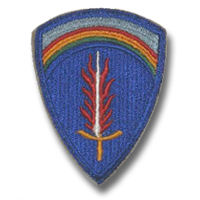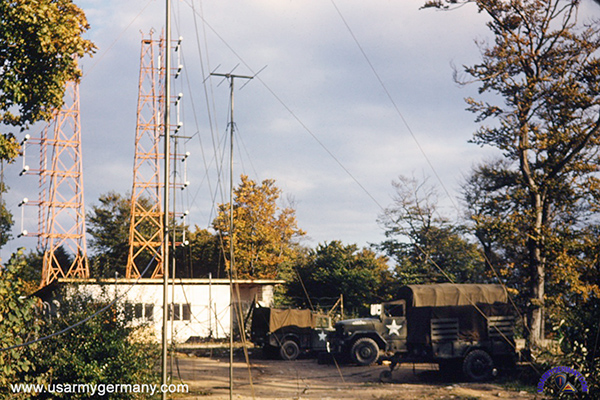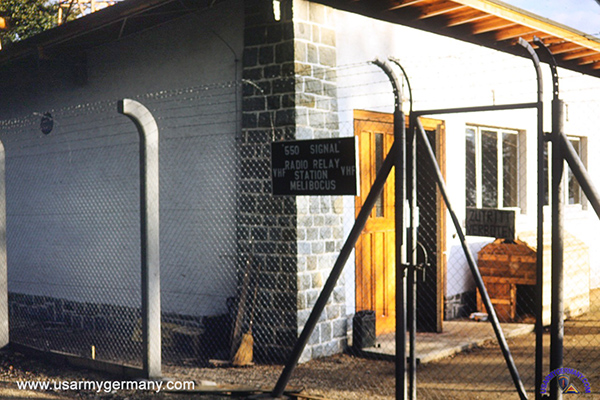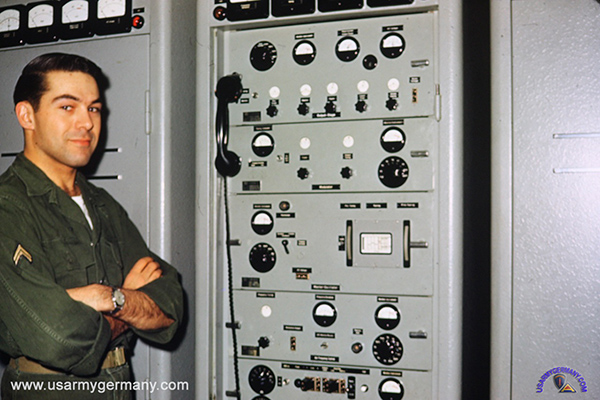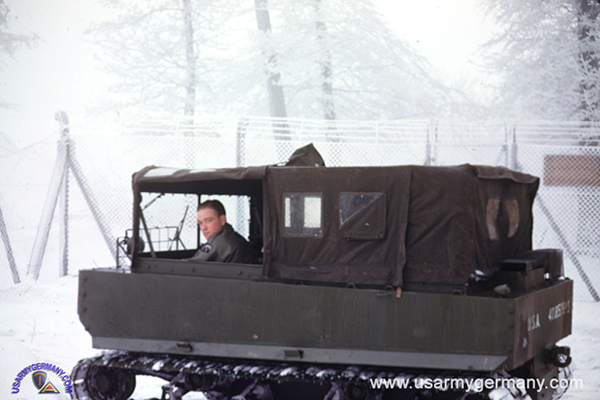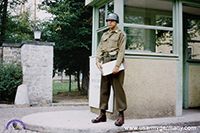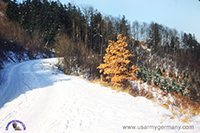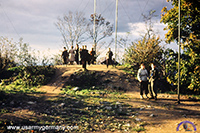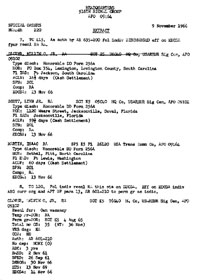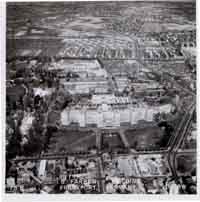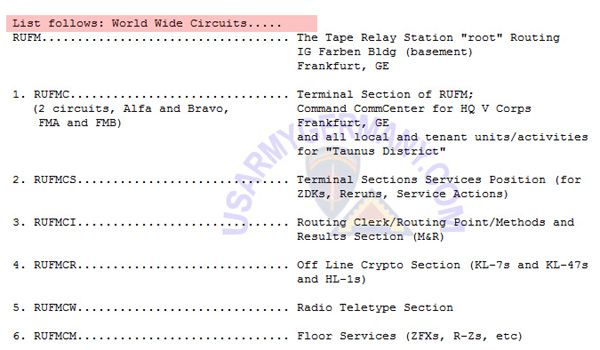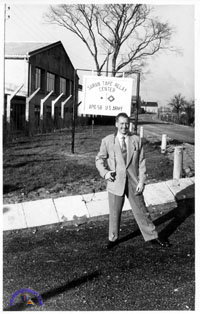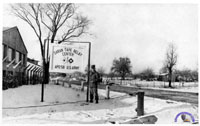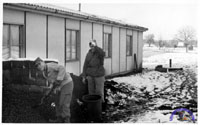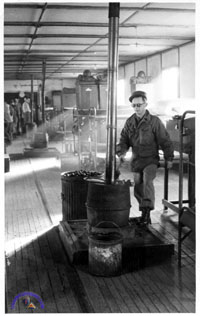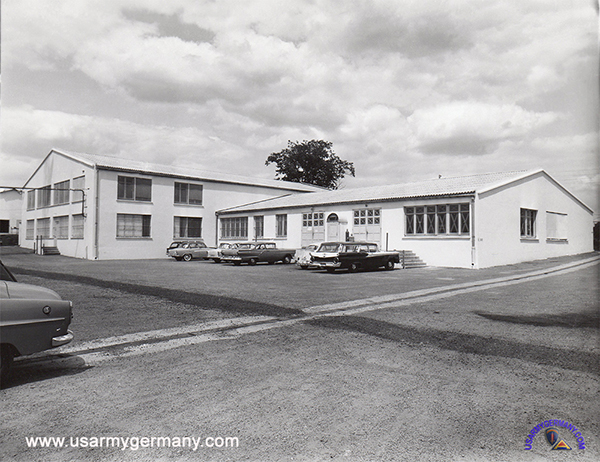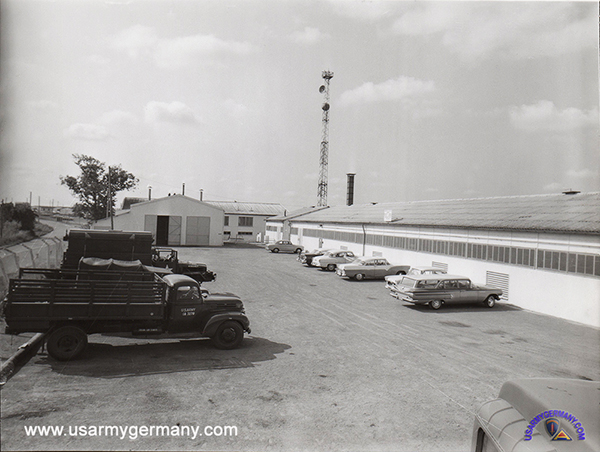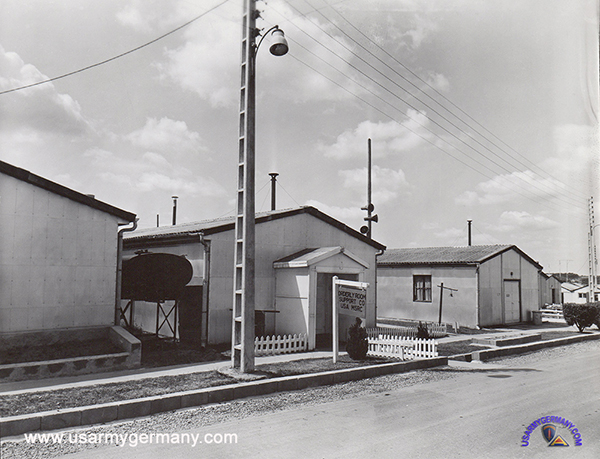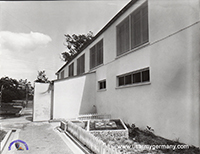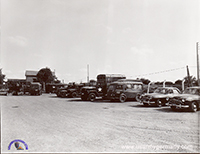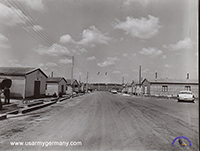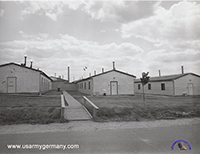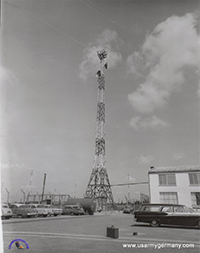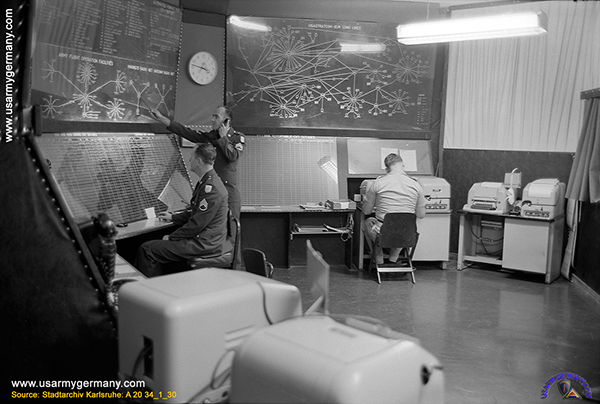| If you do
NOT see the Table of Contents frame to the left of this page, then Click here to open 'USArmyGermany' frameset |
||||||||||||||||||||||||||||||||||||
4th Signal Group |
||||||||||||||||||||||||||||||||||||
|
|
||||||||||||||||||||||||||||||||||||
|
||||||||||||||||||||||||||||||||||||
|
|
||||||||||||||||||||||||||||||||||||
| History | ||||||||||||||||||||||||||||||||||||
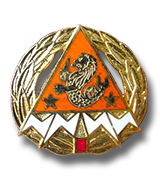 4th Signal Group DUI 4th Signal Group DUI |
||||||||||||||||||||||||||||||||||||
| (Source: STARS & STRIPES, July 29, 1953) | ||||||||||||||||||||||||||||||||||||
| Koenigstuhl VHF Radio-Telephone Station The Koenigstuhl VHF Station, atop the Koenigstuhl mountain near Heidelberg, is a key element of the USAREUR radio telephone communications network. The 50 men stationed at this site belong to various units: All of these units are part of the 4th Signal Service Group, headquartered at Heidelberg. Site OIC is Capt F. W. Baertschiger. |
||||||||||||||||||||||||||||||||||||
| 550th Signal Company | ||||||||||||||||||||||||||||||||||||
| (Source: Email from Jim Scheibner, 7793rd Micro Wave Signal Pltn, 1952-53) | ||||||||||||||||||||||||||||||||||||
| I was drafted for the Korean war in April 1951, and because I could read a schematic drawing I was detoured through Camp Gordon to Ft Monmouth for ten months and subsequently Karlsruhe, Germany, the 7793rd Micro Wave Signal Platoon in May 1952. I am not sure what the relationship was with the 550 Signal Company, but I think we were attached. The story was we were to install and maintain a GE microwave system, but it was months overdue. So I did chores, drilled, and pulled guard duty until I was bored stiff. Some time that summer I was promoted to temporary corporal, a year after becoming PFC, temporary because promotions had been frozen that spring. Therefore no raise. (The following spring of 1953 the freeze was lifted and the promotion automatically happened, with a raise from $87 to about $125.)
Addition: I dug out the remains of my old military orders to clarify my organization in Germany and found that I was a member of 7793rd until I was posted to Melibocus as a member of 550th Signal Company, and was separated from the 550th when I left Germany. I don’t remember a transfer, but——-. |
||||||||||||||||||||||||||||||||||||
We lived in a huge house commandeered from some Nazi bigwig. It was stone, three floors, many rooms, with a kitchen and servant quarters in the bottom floor. We were able to hire two German women, one to cook and serve meals, and the other to housekeep. We bought groceries at the PX in Darmstadt and some on the local market, and we were able to hire the two women, pay expenses and still come out ahead on our living allowance. Another group of GIs lived in the same house independent of us. Many evenings the off duty four of us would drive to a very small town called Jugenheim to eat at a restaurant called Drei Mohren (three chimney sweepers). That Winter we had some big snows and had some tough times getting up and down the hill. We had a 3/4 ton dodge 4x4 (power wagon type) with chains, but had to shovel in spots (no snow plows on that road). We were able to borrow a Weasel, a small tracked rig built by Studebaker, from the Darmstadt HQ for a couple weeks. The people at the restaurant we ate at sometimes called it Das Kleine Schnee Panzer. (The little snow tank). |
||||||||||||||||||||||||||||||||||||
We had a telephone line using field wire running cross country down the mountain about two miles, where it was spliced in to a German telephone line. Our part of the line was tied to trees, we carried a short ladder cross country to tie the line up. A big wind that early spring blew a bunch of trees blew down, so we laboriously spliced and fixed the line. A few days later the line went out again, so a couple of us packing the ladder and a coil of wire followed the line down the hill. We found a crew of Germans with axes and saws cutting up the windfalls, and they had sawed down a tree holding our line. It was the only tree they had cut which was not a windfall. They were laughing at us and thought it was pretty funny. We fixed the line then Sgt Follett and I went back up the hill and got 2 M3 “grease guns” which were cheap sub machine guns that fired .45 cal pistol ammo, several extra barrels and 500 rounds of ammo, went back down the hill. We got about 50 yards from the German woodcutters, then took turns firing the machine guns at the sides of an 8” tree, until it fell. By that time the Germans were gone, and we had no more phone line problems. Sometime early that Spring (1953) the GE Microwave equipment arrived in Germany and my old buddies were put to work installing and checking it out on “Castle Hill” in Heidelberg. The promotion freeze had ended and I was a full blown corporal. As such I replaced S/Sgt Louis Follette (rotated to States) as supervisor of the Melibocus station for about six weeks before my rotation back to the states. None of the GE microwave gear was operational by the time I left In April. |
||||||||||||||||||||||||||||||||||||
|
||||||||||||||||||||||||||||||||||||
| (Source: STARS & STRIPES, Nov 10, 1953) | ||||||||||||||||||||||||||||||||||||
| The 315th Signal Construction Battalion was reorganized and redesignated as the 315th Sig Bn (Microwave & Radio Relay) in late October. Concurrently, it was relieved from attachment to 7th Army and attached to the 4th Sig Svc Gp. The battalion is located at Smiley Barracks, Karlsruhe and is commanded by Lt Col Lloyd Colvin. (The last CO of the 315th Sig Const Bn was Lt Col Halvor T. Daracaott.) |
||||||||||||||||||||||||||||||||||||
| 1956-57 Annual History | ||||||||||||||||||||||||||||||||||||
| (Source: Annual Historical Report, 1 July 1956-30 June 1957, 4th Signal Group, APO 403) | ||||||||||||||||||||||||||||||||||||
|
At
the time of this report, the 4th Signal Group comprised the following
units:
|
||||||||||||||||||||||||||||||||||||
|
||||||||||||||||||||||||||||||||||||
| The operating
elements of the Group manned a wide-spread network of Signal installations
extending from Bocksberg, Germany in the Northeast to Maison Fort
(Orleans), France in the South and Cherbourg, France in the West. The mission of the 4th Sig Gp was to operate All of these installations, except the multi-channel radio telephone system, were operated by personnel of the US Army Signal Service Battalion, Europe. Personnel of the 102nd Signal Battalion (Microwave & Radio Relay) operated the Radio Telephone System. Through the two battalions, the Group exercised operational control over all fixed-plant signal communications facilities serving Headquarters, USAREUR. Specifically, 4th Sig Gp operated the following installations and facilities: |
||||||||||||||||||||||||||||||||||||
|
||||||||||||||||||||||||||||||||||||
|
||||||||||||||||||||||||||||||||||||
|
||||||||||||||||||||||||||||||||||||
| The
5th Aviation Operating Detachment (Army) was attached to the Group
on October 19, 1956. The Det's primary mission was to provide a Flight Following System for all Army Aviation in Europe. In order to accomplish this mission, the Det set up seven Approach Control Teams; fourteen Air Traffic Control Teams; and one Air Traffic Control Center. |
||||||||||||||||||||||||||||||||||||
|
||||||||||||||||||||||||||||||||||||
| (1) NOTE: More about this battalion on the 102nd Signal Battalion Page. | ||||||||||||||||||||||||||||||||||||
| (2) NOTE: More about this unit will be posted in the future on the 59th ATC Battalion Page. | ||||||||||||||||||||||||||||||||||||
|
|
||||||||||||||||||||||||||||||||||||
| 1953 | ||||||||||||||||||||||||||||||||||||
| (Source: Email from Val Henneberg, 4th Sig Gp, 1953) | ||||||||||||||||||||||||||||||||||||
| I joined the
4th Signal Gp in 1953 at Mannheim-Seckenheim with my first assignment
as mess officer for the 7774 Signal Bn and was quartered in a little
hotel diagnally across from the Stadtgarten Officers Club in Heidelberg.
I later was made Company Commander of Headquarters Company, 4th Sig Gp until Col Philip Rose (4th Gp CO) picked Capt Cecil Nutt, Hq Co CO 7774, and myself to choose a team and move to Orleans, France to build a microwave system from the German border to Orleans where we would tie in with a system to be built by an Air Force team. Our sector would tie into SHAPE at our Fountainbleu station. Within three days, Cecil and myself had turned over our companies, chosen three lieutenants who were excellent engineers with construction backgrounds and 103 capable enlisted men including my 1st Sgt, my supply Sgt, and Capt Nutt's motor Sgt. Capt Nutt commanded the detachment and I acted a operations officer. By the end of six months we had in operation a temporary 13 station system from Orleans to Thionville delivering 48 telephone channels plus teletype. Six months later the operating personnel moved into the permanent brick combination stations and living quarters. During that year, my construction teams often worked twelve hour days seven days a week and had to be ordered to take two or three days off to offset fatigue. The two tower crews built 13 self supporting microwave towers 40 feet across at the base and each mounting 4 three meter dishes fed by copper, gas filled coax. At that time it was state of the art. The installation teams used French women we hired to wire in the frames for the GE equipment which we had to use since the French government refused to let us bring German AG Lorenz or Siemens Halske into the country. After construction was complete, I went back to Germany to the southern link based in Munich and Cecil Nutt, now Maj, was given command of the Cherbourg transatlantic cable head along with the cable ship which were also part of the 4th Gp. Imagine a US Army Signal Officer with an oceangoing ship in his command. Incidently, while in Munich I met a lovely German girl with whom, last November, I celebrated our 48th anniversary. Sorry if I rambled but reminiscing is enjoyable. Val G. Henneberg, USA Ret. |
||||||||||||||||||||||||||||||||||||
|
|
||||||||||||||||||||||||||||||||||||
| 1958 | ||||||||||||||||||||||||||||||||||||
| (Source: Email from Phil Konitshek, I&M Section) | ||||||||||||||||||||||||||||||||||||
| I was with the
4th Sig Grp from November 1958 to October 1960. I was based in the
I & M (Installation and Maintenance) Section. We maintained all the microwave towers of the 102nd Signal Battalion in Germany & France. I was in charge of a installation team installing Siemens Microwave equipment at various sites in France. We also maintained the tower at SHAPE Headquarters outside Paris, France. Climbing the towers was what I really enjoyed doing over there. (I had a love / hate relationship with that tower. It was over 100 ft high and 12" wide ) We also maintained the lights on the Armed Forces Network tower in Heidelberg, Germany. Whenever any tower had two or more tower lights burn out, we had to go at a moments notice by plane or truck to replace them as soon as possible. We used to be on TDY most of the time over there. Would you believe that the army paid us $19.00 a day to go to Paris, France. That was SHAPE site. I have been there at least 15 times. We had our barracks in Heidelberg at the Patton Barracks. Near the end of my tour there, our company moved to a location just outside of Mannheim. I am not sure of the name of the barracks there. In between that time, the company moved to Seckenheim for a short while. I still try to find some of the guys I worked with over there. No luck yet. I came to Germany from Fort Monmouth, New Jersey, where I went to Microwave radio repair school for 32 weeks. My class was going to Korea when they finished school. I did one week of class over again, and I ended up going to Germany (smile). I came to the 4th Sig Grp as a PFC. After two years I became a Spec 5. Phil Konitshek ADDITIONAL INFORMATION My job was as Team leader of the Installation & Maintenance Team of the 4th Signal Group. We maintained most of the Microwave Radio sites towers in both Germany and France in 1958 - 60. I think it was broken up after that. All the work was done at all the 102nd Sig Battalion sites. Our shop was located about a few K's (kilometers) above Seckenheim, at a airfield that was bombed during the war. We had a Warrant officer in charge of our group. There was a motor pool based there that is gone now. We used to report there whenever we were in town. We had all of our supplies there. Also the equipment repair shop that repaired the electronics for the 102nd was there also. The Germans that worked there were good. They made some tools for us. We had a Master Sgt, Sgt Williams that actually ran the shop and helped us on the road. Sometimes I think being in the HQ company at Patton Barracks was just a front to park us somewhere. Because my group never did anything at the company. We had a strictly a Tower crew that did all the big jobs on the towers. They were a wild bunch. I picked my own team since I had MOS 281.1, which was a microwave radio repair technician. Everyone else was a telephone repair person. We were called out to replace the lights on top of the towers, if 2 or more lights went out. It was emergency conditions at that time. We used helicopters, planes or trucks to get to the sites. We spent a lot of time in France at some sites, removing the old microwave equipment and adding new Siemens microwave systems. One time, when a high rank officer visited a site in Germany, he grabbed a group of jumper wires, and some broke. So he said for my group to replace all the jumpers on the mainframe in all the sites, and he wanted 2 inches added on each jumper. So I cut a pencil into a 2 inch section and we went to all the sites that had the mainframes and ran new jumpers. Another time, I was told to change the light on the AFN Radio tower in downtown Heidelberg Germany. The problem was that I could not touch the tower because of the wattage, which was very high. So I went there before the system was turned on in the morning. I climbed the tower, which was a tube type tower. After I got up on the tower, they turned on the power which made the tower HOT. Now I could not get down off the tower without killing myself. I had to jump into the chainlink fence without touching the tower at the same time. Another time, we were told to pound a 6 ft ground rod into the ground next to some towers. We had to loosen one big bolt at the bottom of the towers and anchor it to the grd rod. One ground rod we banged into the ground made a u-turn and popped up behind us. We cut off the part that popped up. We were mostly on TDY during all those times at the sites. We never stood for inspections or any other functions in the company. That was my 2 years in the 4th Sig Grp. After I left, the rest of the men in the group went to the 102nd Sig Battalion. That was the last I heard of them. |
||||||||||||||||||||||||||||||||||||
| 1966 | ||||||||||||||||||||||||||||||||||||
| (Source: Annual History, U.S. Army, Europe, 1 January -31 December 1966) | ||||||||||||||||||||||||||||||||||||
| The 4th Sig Gp and its subordinate units were transferred from USAACOM to STRATCOM-EUR on Aug 25, 1966. | ||||||||||||||||||||||||||||||||||||
| If you have more
information on the history or organization of the 4th Sig Gp, please
contact me |
||||||||||||||||||||||||||||||||||||
| 1968 | ||||||||||||||||||||||||||||||||||||
| (Source: Email from Joe David) | ||||||||||||||||||||||||||||||||||||
| I just found your website on USAREUR Units and Kasernes, especially the one on Signal Service Group 4. I was assigned to STRATCOM-EUR right out of SOBC at Ft. Gordon. My wife and I arrived in March of 1968, assigned to Signal Service Unit Worms. I was Assistant Operations Officer. After attending all the available schools I was reassigned to Signal Service Bn 4 in Mannheim as the Adjutant. Capt. David Anderson was the Acting CO. I later became the Assistant S3, and then S3. When the Bn was collapsed and pulled into the Signal Service Group 4 HQ at Karlsruhe we moved there and I was the Comm Center Operations Officer until I got out in March of 1971. It was quite an interesting three years. |
||||||||||||||||||||||||||||||||||||
|
|
||||||||||||||||||||||||||||||||||||
| USAREUR Signal Center | ||||||||||||||||||||||||||||||||||||
 |
||||||||||||||||||||||||||||||||||||
| (Source: STARS & STRIPES, March 2, 1963) | ||||||||||||||||||||||||||||||||||||
| The USAREUR Signal Center celebrated its 1st anniversary (at Campbell Bks) on March 1, 1963. CO of the Signal Cen is Lt Col Vernon B. Drum. Units assigned to the Signal Center: These units enable the Signal Center to provide HQ USAREUR with all forms of communications facilities. Local communications include a 2800-line dial telephone exchange and a 26-position toll switchboard which provides the Army Flight Operations Center (FOC) with direct service to 36 air traffic centers throughout Germany. The telephone exchange is also USAREUR's major switching center for international calls. The Signal Center provides direct distant dialing to all military exchanges in Germany. A new transistor dial system is currently being installed that will provide the same capability between militarty posts in Germany and France. The communications detachment links HQ USAREUR with Army Global and Theater teletype nets. These nets use high-speed semi-automatic teletype equipment and teletype conference and facsimile devices. The Radio Branch operates voice, teletype and manual radio facilities -- both fixed-station as well as mobile. These facilities are part of the administrative net and are used for tactical purposes as required. The Radio Branch also operates a MARS radio station. |
||||||||||||||||||||||||||||||||||||
| (Source: Email from Melvin Glover) | ||||||||||||||||||||||||||||||||||||
|
||||||||||||||||||||||||||||||||||||
| The Signal Center was a 24 hour a day operation with shift workers. Upon arrival we wore the USAREUR shoulder Patch then later due to changes in the Signal Corp we wore the STRATCOM Patch. Also, upon my arrival we were under the 4th Signal Group and on my depature in 1966 we were under the 516th Signal Group. Melvin Glover ADDITIONAL INFORMATION: Just recalled some other information that might be of interest. USAREUR HEADQUARTERS had a train (engine with 3 or 4 cars). The Signal Center was responsible for the maintenance of the Radio equipment on board the train. Also the Signal Center furnished the radio operator. (Usually a SGT E-5 in rank was the Radio Operator for the train.) Any time the train pulled out the Radio operator was on board. This was a plush job. If you did not screw up you got a promotion. Dont recall which USAREUR COMMANDING GENERAL, it could have been General Freeman, liked to listen to the latest news from AFN each morning as he had breakfast on the train. The radio operator had the job of recording the news and playing it to the General as he dined. I was not one of the radio operators but several times I went aboard the trains to change out communication equipment for maintenacne. There were actually two trains if I recall right . . . one had more cars than the other. The cook on the train was an enlisted man. I can recall one cold night when we were working he fixed some sandwiches and coffee for us. We thought that was a big deal sitting in the General's train having a snack. |
||||||||||||||||||||||||||||||||||||
|
|
||||||||||||||||||||||||||||||||||||
| Signal Service Unit, Frankfurt | ||||||||||||||||||||||||||||||||||||
| (Source: Email from David C. Freed) | ||||||||||||||||||||||||||||||||||||
| I was in the
3816th Signal Service Unit,
Frankfurt, Germany from 1966 to 1969, working mostly comm centers
in several locations. Sometime in late 1966, the 3816th was dropped from the unit's name, and we were simply known as "Signal Service Unit, Frankfurt", or SSU. Around that time, STRATCOM was taking over most Signal units in Europe as the Army was building a new Signal-oriented kingdom for itself. Prior to that time, the USAREUR Signal units came under an umbrella organization (but not necessarily a separate command) which was then called STARCOM. STARCOM was an acronym for "Strategic Army Communcations". SSU Frankfurt hosted a large, Major Relay Torn Tape Relay Station at the IG Farben Building in downtown Frankfurt, which was my duty station. It's root routing indicator was RUFM, and it had at least 70 circuits in those days, maybe many more. In addition, SSU-F handled MARS, Telephone exchanges, ELLA Long Lines, and had numerous detachments and spin-off units operating in such exotic parts of Germany as Würzburg, Fulda, Giessen, Hanau, North Frankfurt, Gelnhausen, and numerous other locations. When STRATCOM came along, 4th Signal Group eventually went away. It was replaced by "USASTRATCOM-Europe", with the SSU's immediate HQ unit being in Munich in the 4th follow-on elements. I would be happy to pass on what I know of my own experiences with 4th Sig Gp and specifically, Signal Service Unit in Frankfurt and Frankfurt Major Relay Station (and some of it's tribs). You should organize a 4th Signal Group veterans groups on the Internet. I am sure there are several of us still around who would like to "talk shop" once more. FYI, I'm still in the commcenter business, although it's changed dramatically since the 50s and 60s. I'm a Defense Contractor and COMSEC Custodian for a larger contractor and PSA (SSO) among other things and hats..... (a far cry from being a First Sergeant!). All my co-workers are former GIs too, mostly MI guys and senior officers. |
||||||||||||||||||||||||||||||||||||
| ADDITIONAL INFORMATION: It's amazing how time "flies". Thinking back, it's been almost 40 years since I was there! The last tape relay that I worked in was VII Corps, 34th Signal Bn (Stuttgart) in the mid-1970s during combined WINTEX/REFORGER exercises. By then, all of the Army's tape relay equipment had been consigned to the junk dealers and scrappers, and we had to make do with TT-76s as the prime relay gear.......(what a fiasco that turned out to be!). Loved the concept of the tape relay station, and enjoyed the work. Aside from it being phased out, by the 1970s, few in the Army even remotely remembered how TRCs work. Neighboring NATO countries had relays, but nothing on the order (size) of what we had. I spent some time with the 4th CMBG (Canadian Mechanized Battle Group) in Lahr, Germany. They too had a tape relay, but it was a small thing compared to what we had..... |
||||||||||||||||||||||||||||||||||||
| RESPONSE TO MYSTERY PHOTO #7 (link): I was browsing your excellent sites of the US Army, Germany a few days ago, and noted a 1956 photo of the rear, left side of the IG Farben Bldg in Frankfurt. There was a question near the photo as to "what" the antenna on the roof went to. I will try and answer that for you. I believe it was to the US Army MARS Station that was located in the Rotunda of the IG Farben Bldg. The MARS station had been established sometime in the 1950s, and was the very first thing anyone saw or noticed when they entered the building from the front (street) entry. This MARS station was magnificient - it was large, nicely paneled, and was certainly a show piece to any visiting officers, dignitaries or enlisted troops. It was run by GIs, mostly with MOS 05C20 (Radio Teletype Operator). The station had a large compliment of HF radio equipment, including at least 3 R-390/URR receivers and an assortment of transmitters, converters and at least one Radio Teletype (RATT) position. The RATT position was a TT-7/TG or TT-9/TG (Model 15 or Model 19 teletypewriter, painted a light gray color). It operated at 60 wpm and was used to send MARSGRAMS - and sometimes, to copy News broadcasts from the various news agencies who still operated commercial RATT (RTTY) in those days. Actually, there should have been three (3) such antennas on top of the Farben Bldg -- all spaced equi-distant from each other along the back side of the roof line. That's because the MARS station had three (3) transmitting positions, each requiring separation from each other due to the nature of HF radiation.The antenna mast(s) that are pictured most likely had dipoles or rhomics running between each mast. I recall seeing wires running from antenna mast to antenna mast in the 60s. Also present, were guy wires for each mast (to hold the antenna mast upright). It is possible that in later years, these antennas might have served other purposes for other organizations. They were there in the 60s when I was there. When I returned to the IG Farben Bldg (by then, renamed the CW Abrams Complex) in 1985 thru 1988, these antennas were gone. I first saw the MARS station upon my arrived at the IG Farben Bldg in 1966. The MARS station was operated by the Signal Service Unit, Frankfurt (3816th Signal Service Unit, 4th Signal Group). In 1966, the 4th Signal Group was a USAREUR unit; around 1967, it became a USASTRATCOM unit. After Signal Service Unit, Frankfurt was reorganized as the 102nd Signal Bn, the new organization didn't want anything to do with MARS. By that time, the Army overall was downsizing most of it's MARS operations, with MARS becoming less and less important to the Army mission. Many fixed-station MARS facilities became the ward of tactical units who operated them sporadically. This MARS station was closed and dismantled sometime in the mid-70s. All cabling, conduits, flooring and the paneled room that the MARS station occupied was all physically removed and replaced with a collection of displays of NATO country flags, and some indoor trees and other large plants, and a sitting area in the Rotunda, which became a lobby. This was during the CW Abrams Complex tenure of the IG Farben Bldg. Not related, but also noteworthy, behind the IG Farben Bldg (CW Abrams Complex) was a large, 300 ft or 400 ft antenna structure, painted red and white. This belonged to the 4th Signal Group (Signal Service Unit, Frankfurt, and later, the 102nd Signal Bn). Mounted on this antenna were several VHF parabolic dishes. This antenna structure had been there at least since the 1960s, and possibly earlier. With the 1980s advent of terrorist activities against US military installations in Europe, the 102nd Signal Bn had a German contract scrapper come in and take the structure down. It took less than 2 weeks to bring it down, piece by piece. It was sold for scrap. In it's place, a hardened, pre-existing concrete water tower was used as a replacement antenna structure. It was near where the old antenna was located, and was unpainted, concrete. The parabolic antennas (dishes) were affixed to the top of this structure, and it remained as such until the CW Abrams Complex building was vacated by the US Army and turned back over to the Germans sometime in the late 80s or early 90s. As a matter of interst, both the old red and white metal antenna structure and the newer concrete water tower structure were both highly visible from as far away as Drake-Edwards Kaserne in North Frankfurt (3rd Armored Division HQ). |
||||||||||||||||||||||||||||||||||||
|
|
||||||||||||||||||||||||||||||||||||
| (Source: Email from David C. Freed) | ||||||||||||||||||||||||||||||||||||
|
RUFM - Major
Tape Relay Station Frankfurt |
||||||||||||||||||||||||||||||||||||
|
||||||||||||||||||||||||||||||||||||
| My own involvement
begins in the Frankfurt Commcenter. Upon arrival, I was told that
SSU Frankfurt operated a large Major Relay station, and that this
station was the Army's 3rd largest relay station in all of Europe.
I am further surprised that there is no mention of Frankfurt Relay
in any historical documents anywhere in any of the signal unit histories
either in or out of the Army. In any event, the routing indicator
of Frankfurt Relay, as it was called, was RUFM. RUFM consisted of
a large tape relay bay (online operations), a floor-services section
(RUFMCM), an off-line crypto section (RUFMCR), a Methods and Results
(M&R) section (RUFMCI), a good-sized terminal station (V Corps commcenter
as well as the relay stations's terminal, RUFMC, and a terminal services
section (RUFMCS). In addition, the relay bay contained numerous circuits
seemingly going everywhere at once. There were always 2 of everything:
2 "Command" circuits to USAREUR/7th Army in Heidelberg, Germany (RUFPAG);
2 circuits to USAF Primary Relay Station (RUFP) in Siegelsbach, Germany;
2 circuits to Pirmasens Major Relay, (RUFD). We also had some circuits
to a couple of minor relay stations: RUFMW and RUFDZ. Then there were
the local-area commands and their circuits: 3rd Armored Division in
N. Frankfurt, (RUFMAD) , 8th Infantry Division in Bad Kreuznach, (RUFMEI),
3rd Infantry Division, Wurzburg, (RUFMAZ) 14th Armored Cavalry Regiment,
Fulda (RUFMAF), Giessen Support Center + units (RUFMAE), 212th FA
Group, Herzo-Base, Stars and Stripes Newspaper in Darmstadt
(RUFMDS) and of course, all of the V Corps tactical circuits (UUFOV,
UUFOVA, UUFOVB, etc). There was also 1 newly installed (temporary)
circuit to RUFG in France, and 2 circuits to the USA Berlin Brigade
(RUFPHA) in Berlin, E. Germany. The Berlin circuits were our "best"
circuits, as these were landline links with 100% reliability, probably
because the East German Army (and the Russians) took very good care
of the lines in the hopes that they might eventually learn something
from monitoring them. Unfortunately, they were secured by KW-26s,
so it's doubtful they got anything useful off of them. My life at Frankfurt started as a traffic "expediter", or what we called a "tape ape". My job was simple: push and pull tape from one circuit to another. I would be required to roam the entire relay bay looking for arriving messages and TDs needing to be fed more tape. Then there were the hourly requirements to send, receive and account for channel checks. In between all of this, monitor reels had to be monitored, changed and replaced on all machines, as they filled up, chad bins had to be emptied and trash had to be bagged. Being that we were a "major" relay, there was lots and lots of tape, often enough to keep us waste-deep in the stuff for most of our shift. The relay station was often hot, and the tape was oiled, so the place always had a "hot, oil" smell to it. It was also very noisy, and I soon realized that I did NOT like working in the relay station at all. On the afternoon and night shifts, were wore fatigues and were allowed to work in our (white) T shirts, due to the heat. Air conditioning in those days was a luxury not always available in the commcenter. The online crypto room by comparison, had great (and lots) of cool air conditioning. They had rows and rows of KW-26s, and those beasts needed the cool air in order to function, as did the KW-7 circuits. One of the jobs I was occasionally assigned to perform was that of ZVA tape cutter. The ZVA position was a multiple-call processing unit consisting of 1 printer and a TD and several reperforators. The idea was to produce a single tape for each addressee called in format line two of a multiple call message (make a bunch of little ones out of one big one). Frankfurt Relay had 2 ZVA positions in those days. Originally, the ZVA positions (2 of them) consisted of German T-100s and associated reperfs, but over time were replaced with 100 WPM US Kleinschmidt TT-98 printers, a TT-122 TD (transmitter-distributor) and 7 or 8 TT-107 reperfs (tape cutters). These Kleinschmidts gave much trouble, as they required near constant maintenance all of the time (typical of most Kleinschmidt teletype equipment of the time). Sometimes, we had "dud" operators. They were usually assigned jobs as "link" men performing circuit HJs on KW-26s. Their jobs entailed moving a TT-98 on a wheeled table from one KW-26 to another about every 15 minutes or so to change over a circuit. We had a lot of circuits, so this was a full time job. Other "duds" were assigned bagging trash duties, emptying chad bins, sweeping floors, and changing tape reels on receiving reperforators and monitor reels machines. There was never a shortage of dummies in the commcenter! Consequently, they came up with or kept alive such interesting references to "tape stretchers", "boxes of channel numbers", "jars of RF", and cases of "LTRS keys". Frankfurt commcenter (the relay) also had a Technical Control section in-house. The sign over it's doorway read "FAX Control" which I assumed stood for Facilities Control. Within Tech Control was a "Cross-Office" function and an "Order Wire" system, of which I knew very little about. There was also a section called "Patch and Test" and several techs who worked there. The equipment at Frankfurt Relay was an odd set up in that we had seen nothing like any of what those guys were using in AIT. We had been trained strictly on US equipment made by Kleinschmidt and Teletype Corp. Everything from TT-4s to the old OD colored "coke" machines used in relay's to some older Model 15s and Model 19s out of the 1940s. Frankfurt had none of this. What they did have was a large amount of German-built Siemens teletypewriter equipment. I do not know the nomenclature of the German relay equipment, only that it was built specifically for the US Army and no one else and it was very, very reliable. The page printers of the day were called T-100s, also built by Siemens and incorporated built-in tape gear along with printers and separate DC power supplies. These machines performed on and off line, and were excellent "poking position" machines. Across the hallway, was stored large amounts of Kleinschmidt tape relay machines arriving by the truckload from Signal units allegedly in France. These were AN/TGC-5 tape relay banks, along with numerous AN/FGC-25X table-mounted printers, TDs and reperforators, TT-98s, & TT-107s, etc. These were to replace all that German equipment, as Siemens had told the US Army that it would no longer manufacture teletype equipment for the Army. The "French" connection: This was around the time that the then erstwhile President of France (Charles DeGaulle) had "invited" US Forces to vacate his country, and we in Frankfurt were receiving both some of their gear and their troops. One contingent of 72Bs arrived at Frankfurt one day from a commcenter whose routing indicator was RUFGAE saying they were from Orleans, France. We put them right to work……and were glad to have them. For what it is worth, before arriving in Germany in 1966, my original 72B20 orders from Fort Gordon were to the 1st Logistical Command (COSCOM) in France, but for reasons already mentioned, I was diverted to Frankfurt. Several folks from RUFG in France came to Frankfurt looking for both a home and job, and many were eventually assigned to us in late 1966, while others went to Italy. Back in the commcenter, the shift supervisor for the relay part of the shift roamed the floor and hounded the tape apes. I eventually went to work in another section of the commcenter referred to as the "off line crypto section". This was a throw back to the WW II years and was in a separate part of the commcenter where things were very quiet. We had such exotic things to work with called KL-7s, KL-47s and HL-1s and we spoke in "5 letter" code groups. My NCOIC there was from the 32nd Signal Bn and this part of the commcenter was a "Restricted" area - no one could get in, unless you had specific business there. This was good because it kept the Trick Chief and some of the noisy guys out of our operation. Half the time, we couldn't get the HL-1s or the KL-7s to work right, so a great deal of our time was spent in utter frustration trying to manually decode received traffic which had arrived 2 shifts prior, and for which pressure was on to further reduce "handling" time. The off-line crypto facility had it's own routing indicator off the relay floor: RUFMCR. Whenver an "off line" message arrived in the relay for an RUFM addressee, they sent it too us for decoding over a "room circuit". Once it was decoded, we retyped it in "English" and resent it back to the relay floor over the same room circuit where, presumably, it was transmitted further over one of Frankfurt's own tribs to destination or delivered locally via message center (A&D Clerk). The operators and staff make-up of those folks who operated the commcenter (terminal and relay and all other areas) came from both Signal Service Unit, Frankfurt and from folks assigned to V Corps's 32nd Signal Battalion out of McNair Kaserne (Hoechst/Frankfurt). The 32nd Sig Bn guys belonged to V Corps and were supposed to support the tactical requirements when the Signal Bn went to the field. In garrison, they worked the fixed-station with the rest of us. The Shift Supervisors could be from either unit. The OIC and NCOIC belonged to Signal Service Unit, as did the COMSEC Custodian. Sometime in late 1967, a new breed of signal officer showed up at Frankfurt Relay. They called themselves "STRATCOM" and said they were taking over our operation soon. They wore a funny looking shoulder patch, which was orange and white and had what we soon dubbed an "electric basket ball" in the center which was said to represent the "world". No one ever told us "what" world that was. In any event, the patch also featured a lightning bolt going through the "world", so we called it the "world divided by a lack of communication". There was some truth in that monicker……. STRATCOM eventually took over our operation as promised in 1967. 4th Signal Group then became part of STRATCOM or USASTRATCOM-Europe, as it was later known. Immediately, we began having major problems with the new command. The first thing STRATCOM did was boot out all of the resident signal guys from the 32nd Sig Bn, which cut our manpower nearly in half over night. The second major blunder was an agreement STRATCOM made with the outlying tactical units for which our relay supported circuits to provide both terminal equipment and operator personnel to support their fixed-station requirements. By the time STRATCOM got done supplying operators (72Bs) to such places like Wurzburg, Bad Kreuznach, Giessen, Fulda, Hanau, Babenhausen, there were few left to operate the relay in Frankfurt. Most supported units received at least 2 operators from Signal Service Unit. I was one who got farmed out to the 14th Armored Cavalary Regiment in Fulda, to work in the Regimental Commcenter (RUFMAF). While it was a great assignment, compared to working in Frankfurt, it was also busy. I was still assigned to STRATCOM Signal Service Unit, so didn't have to hassle with all of the 14 ACRs day to day tactical requirements. RUFMAF also had two (2) additional circuits of it's own that we had to operate in addition to the main Frankfurt Relay circuit. Other outlying units also had numerous additional circuits (for instance, 3ID out of Wurzburg had 9 circuits). In addition, all of these units were OPCON to V Corps and so had their tactical commcenter circuits as well (field circuits) and their radio-teletype (RTTY/RATT) links to deal with. This was interesting and provided us 72Bs a great Insight into the different methods of passing traffic, since we soon became involved with it whether we liked it or not. Enter such new things as "UU' routing indicators and radio and RATT call signs. Actually, it was a fun time, because we got to see, learn and experience communications in a manner different from simply being a teletype operator. We also got to use something besides the same old gray Kleinschmidt gear. There were R-390 radio receivers, TT-4s, TT-76s, TH-5s and other interesting gadgets to keep us both interested and occupied. The tactical units exposed us to other things as well, such as Radio Relay Carrier (VHF circuits), wire lines (wire dogs), something new called RWI (radio and wire integration) and FM antennas. To add to the interest, there was the NATO "interoperability" thing ongoing at the time, which brought us in line with the local German Army whose only claim to fame in the teletype world was VHF RTTY using Siemens T-100s and similar looking routing indicators like RGFFL, or UK units using teletype machines made by Creed (which were as bad as Kleinschmidts and never worked). French and Turkish signal guys were even worse….but more about those folks in another post. After STRATCOM took over our relay station, all that Kleinschmidt teletype relay gear was finally installed and made operating. It worked very well for a couple of years. Many of the supported outlying commcenters also received Kleinschmidt teletypewriters from Signal Service Unit in Frankfurt. These were mostly AN/FGC-25Xs to replace existing TT-76s, TT-4s, German T-100s and Lorenz LO-15s (German licensed version of the US Teletype Corp Model 15s). STRATCOM did not have a unit crest for the Signal Service Unit in Frankfurt, nor was one ever forthcoming. Prior to the advent of STRATCOM taking over our unit, SSU had a previously awarded Meritorious Unit citation from a previous conflict. This was worn on the lower left sleeve of the dress uniform and was in the form of a small patch with a gold wreath. Later, this award was redesigned as the current Meritorious Unit Citation Ribbon and was worn on the right side of the breast above the right coat pocket. STRATCOM disallowed the wear of this decoration by all of the troops assigned to SSU. (In retrospect, probably because it was not earned by STRATCOM since at the time it was awarded, STRATCOM did not exist. In those days, there was no "grandfathering" in STRATCOM for pre-STRATCOM members of the unit). The 3816th Signal Service Unit members also wore, and were encouraged to wear, the Signal Corps orange ascot (bib scarf) which may of us did with our fatigues and khaki uniforms. Under STRATCOMs tenure, these too were outlawed. STRATCOM became to us, a generic, sanitized unit or what many would eventually refer to as a "slave" ship operation. Professional Army standards and decorum appeared to go away with the new management and was replaced with a cold sense of apprehension, uncertainty and tension……and was further aggravated by the arrival of a new, mean, self-righteous Sergeant-Major who would go on to terrorize the unit and some of the neighboring entities as well. His actions would facilitate a unit rebellion which ultimately would cost the unit commander his job. Most of the circuits in Frankfurt Relay were full-duplex, 60 WPM with the exception that Heidelberg, Berlin, Siegelsbach, Pirmasens (and all the other relay stations to whom we were connected), were 100 WPM. We had several half-duplex KW-7 circuits which were 60 WPM, as were all of the tactical circuits in those days. All of the RATT/RTTY links were KW-7 circuits, and they too were set up for 60 WPM. Once STRATCOM settled in, both the character and make-up of the unit and it's mission changed dramatically. Under USAREUR, we had run our operation like every other place in the Army with a lot of spit and polish, inspections, good soldier discipline, pride, and efficiency. With STRATCOM came a lot of animosity in the ranks, "make work" assignments, harassment, security violations, and a general distrust of one another and a breakdown in troop discipline. One of the things STRATCOM created in the relay and in other units was the phrase "F- the position, police the position" which suggested that cleaning equipment, waxing and buffing commcenter floors, shining boots and having starched fatigues was more important than performing our mission of moving traffic, even to the point that our Commander would literally shut down the entire operation on a whim if he wasn't satisfied with how the floors looked. It was ludicrous, the crap that was coming our way! Some of this nonsense culminated in a serious mutiny (1968) in the unit and our commander was eventually relieved (fired). The Overseas Weekly of the era had a field day with the story. In all fairness to STRATCOM, they were truly in their "growing" period. Within STRATCOM, particularly USASTRATCOM-Europe, things would get a lot better very quickly to a point where everyone would eventually seek to be a member of this organization if they were a Signal Corps member. Once STRATCOM took over our relay station, it became readily apparent to most of us, (even the lower ranking troops) that there was animosity brewing between "our" outfit and the local Security units. This meant the Army Security Agency (ASA) folks who were responsible for insuring compliance at the time with Army Regs and other national security directives regarding COMSEC, security, etc. The ASA inspectors would arrive for a security inspection and made it known that they were here to "shut down the commcenter" any way they could from a security standpoint. What we didn't know at the time was that STRATCOM also wanted to shut down the Frankfurt Relay, but for a different reason. AUTODIN was on the horizon, and Frankfurt Relay was not going to be part of AUTODIN because it would no longer be needed. In late 1968, we began to see more changes take place at Frankfurt Relay. One of the most significant events was the activation and start-up of the new Pirmasens AUTODIN Automatic Switching Center (ASC). It carried the routing indicator RUFT and came online in late 68. It's immediate effect was to diminish the importance of both Frankfurt (RUFM) and Pirmasens (RUFD) torn tape relay stations. RUFT had the effect of reducing both facilities to Minor Relay station status. One by one, Frankfurt Relay's major circuits were rehomed to RUFT (Pirmasens). Along with these changes came changes in routing indicators for Frankfurt and many of it's tributary stations. RUFM became RUFTTBA. Giessen became RUFTTBD, etc Not long afterward, I left the Signal Service Unit in Frankfurt and the 4th Signal Group to serve in the 21st Signal Group in Vietnam. That was yet a different take on the Signal Corps and is a story for another time…… In 1987, I was fortunate in that I was once again assigned to Frankfurt, courtesy of the US Army. Naturally, I took a look at the old place, including the spaces once occupied by both Signal Service Unit, Frankfurt, and it's Major Relay Station. Absolutely nothing remained, nor did any of the soldiers there at the time have any recollection of any of the foregoing, including the current, resident Signal Battalion troops. The unit's barracks area was now a German-owned and rebuilt apartment complex (on Henry Budge Strasse). The IG Farben Building still stood, but was now renamed the CW Abrams Complex. No one there at the time I was there in 1987-88 even recalled the name IG Farben Building. The tape relay was long gone. The space was in use as part of a very, very large SCIF by an INSCOM unit to which I was assigned as the SSO. All tech control, relay bays, terminals, wiring, and crypto rooms were long gone, as were their walls, partitions, cross offices, patch and test facilities and other associated technical trappings. The area was one large room, mostly used for storage. The then current SSO shop did have a DSSCS (back channel) multi-circuited commcenter using Teletype Model 40 teletype equipment and KW-26s still along wth some of the newer AN/UGC-74s (teletypewriters) and KG-84s (crypto units) These were operated by the SSO which belonged to the 302d MI Group (Frankfurt). What was left of the Signal Service Unit in Frankfurt and other areas (then) belonged or reverted to the follow-on organization which was present: 102nd Signal Bn, 2nd Signal Brigade of the 5th Signal Command (formerly USASTRATCOM). Those folks still had the same general mission as the old SSU-Frankfurt, and they still had a good-sized commcenter operation using something called an AMME, or Automated Multi-Message Equipment system, essentially an automatic minor relay for the local area. USASTRATCOM or STRATCOM went away to become the US Army Communications Command (USACC), which later became the US Army Information Systems Command (USAISC). The 32nd Sig Bn no longer had a part in the current fixed-station operation. They continued however to operate their tactical teletype circuits at the CW Abrams complex inside tactical vans (AN/MSC29s and AN/TSC-58s, mounted on 2 ½ ton trucks) and doing a brisk telecomm business. The 102nd's AMME facility had been relocated to the CW Abrams 'annex' an add-on facility next door to the main building. The large, beautiful MARS station that once adorned the rotunda to the IG Farben building was dismantled by the 5th Signal Command and had been replaced by a display of NATO flags. Typical of 5th Signal Command thinking, everything has been downsized, greatly automated and severely undermanned. They called that progress! A list of some of the routing indicators that Frankfurt Relay served is available from memory, if anyone is interested. While they serve no purpose today, they are great for discussions. In those days, we used ACP-127 as our Bible and surprisingly, it's still out there and can even be downloaded from the Internet, along with other ACPs. ADDITIONAL INFORMATION Having walked the relay bays at Frankfurts Tape Relay (RUFM) during the 1960s as a "tape ape", I had pretty much memorized all of the circuits and their Routing Indicators. What follows is somewhat of a reconstruction of some of them, although the list is not yet complete. Perhaps you can add them to the segment for the Signal Service Unit Frankfurt (3816 Signal Service Unit, USAREUR (later USASTRATCOM). Many of these stations had circuits of their own that emanated to many of the smaller Kasernes all over Germany. I do not have a list of these. However, in the Army, teletype circuits were everywhere.....and everyone was served. Anyone who did not have access to a CommCenter teletype facility then generally had access to Radio Teletype (RATT) which was a part of the CommCenters operation too (FM 24-17). Many NATO circuits were included too, but again, at this point, I don't have all of them listed, since I am still researching them. The W. German Army played a big role here too, especially their III Korps out of Koblenz, GE ("Deutscheseck"). They operated 3 large tape relays: 1 at Koblenz in the "fortresss"; 1 at Massweiler; and 1 at Teufelsberg... Massweiler became a NATO facility and Teufelsberg became an Intel operated CommCenter in later years by various "spook" outfits |
||||||||||||||||||||||||||||||||||||
|
||||||||||||||||||||||||||||||||||||
| Click here for an extensive list (not complete) of the old Frankfurt Tape Relay RUFM -- Tributary Stations and 7th Army Tactical routing indicators. Frankfurt, prior to 1960, was "RUFY". It was the V Corps CommCenter and while the Routings changed over the years, V Corps stayed in the Frankfurt (IG Farben Bldg, later CW Abrams Complex) until the Iraq war dragged them into that part of the world. The V Corps CommCenter in later years, became an AMME facility -- minor relay, and was such right up until I left in 1988.....for all fixed-station traffic. Tactical vans were always parked out back of the HQ building and these housed all of the tactical and NATO circuits to which V Corps connected with. |
||||||||||||||||||||||||||||||||||||
|
|
||||||||||||||||||||||||||||||||||||
| US Army Primary Sig Relay Center-Pirmasens | ||||||||||||||||||||||||||||||||||||
| (Source: Email from Ken L. Foster) | ||||||||||||||||||||||||||||||||||||
| I don’t know the “Husterhoeh Kaserne”. My Last duty assignment was “SptCo, USA,PrimSigRlyCen,APO 189 – USAREUR” at “D’Isly Kaserne Pirmasens, Germany”
The flaming sword patch was on my uniform. We had a total of about 200 people there including WACs. Not counting civilians. It was in a secure building with lots of teletype and related machines in it. The civilians worked on the non-classified section and the Army worked in the classified section. We never went into the field. We had our own mess hall but there were a number of mess halls and barracks beside and all around us. I am in a golf league here and was talking to one of the guys and found out that he was in the Signal Corps and was stationed in the same facility in Pirmasens that I was and at the approximate same time. We were not in the same company, however, and I have no recollection of ever meeting him over there. Has there been anyone inquiring about the company or the people that were stationed there? Is this Army post still there or did they move it and now call it Husterhoeh Kaserne? |
||||||||||||||||||||||||||||||||||||
| (Source: Email from Dennis Heath) | ||||||||||||||||||||||||||||||||||||
| US Army STRATCOM Facility, Pirmasens (Call Sign RUFD) I was stationed in Pirmasens, Germany at this facility from 7/1964 through 6/1967. I was a Signal Corps Officer and was in charge of the fixed communications (teletype at that time) facility for about one year of my 3 year tour there, 1965-1966, I think. The commanders I served under were MAJ Sam Pierce and MAJ John Lutsch. Our SMAJ was SMAJ Cain; a few of the other NCO’s were SSGT Heininge, SSGT Savino, SFC Hardwick.; DAC Jim Petrmichl; other officers, CPT Curt Washburn (deceased); CPT Rich Beller; CPT Thad Jackson; CPT George Dumas; CPT Nancy Murray, CPT Mike Simmons and CPT Hartmuth Schmahl. Rich Beller was career Army. My wife and I recently caught up him and his wife in Texas while our grandson completed military firefighter school at Goodfellow AFB, San Angelo, TX. We had secure (classified) teletype circuits all around the world…FT Detrick; FT Meade; Asmara, Ethiopia; Leghorn, Italy; Ankara, Turkey and more. We were a 24/7 operation with both enlisted men and woman. When I left FT Gordon for Germany in June 1964, we were told we were part of the 7th Army and wore the "seven steps to hell” patch. Shortly thereafter, we became part of USAREUR and then, six months later, we were STRATCOM. Think our Headquarters was in Heidelberg. My wife, Judy, and I had two children born at the Muenchweiler Army Hospital near Pirmasens. I hope this really old info helps. |
||||||||||||||||||||||||||||||||||||
| US Army Major Signal Relay Center-Saran | ||||||||||||||||||||||||||||||||||||
| (Source: Ted Kwarchak) | ||||||||||||||||||||||||||||||||||||
| I would be very interested in hearing from anyone who has information about these pictures and the Saran Tape Relay Facility. Please contact contact me |
||||||||||||||||||||||||||||||||||||
|
||||||||||||||||||||||||||||||||||||
| 1961 | ||||||||||||||||||||||||||||||||||||
| (Source: Email from Tim Casey) | ||||||||||||||||||||||||||||||||||||
| I was stationed
in Saran, France, 1961 to 1965 and our unit's headquarters was the 4th Signal Gp in Heidelberg. The ACAN facility in Saran, France, had various unit designator over the time it was active. It started out as the 7774 Sig Unit, then came under the Sig Service Bn-Europe, then US Army Major Sig Relay Center-Saran, and finally was US Army Stratcom Fac-Saran, France. Met and married my wife there in Saran. In addition, I also served in the 73d Sig Bn, and 2nd Sig Gp and 22d Sig Gp, and the 160th Sig Gp, and the 5th Sig Command. Finally retired as Bn SGM of the 43d Sig Bn. |
||||||||||||||||||||||||||||||||||||
| 1962 | ||||||||||||||||||||||||||||||||||||
| (Source: Email from Gary Imhoff) | ||||||||||||||||||||||||||||||||||||
| I served in Saran, France from May 1961 to November 1963 at the Major Signal Relay Center (MSRC) RUFG. | ||||||||||||||||||||||||||||||||||||
|
||||||||||||||||||||||||||||||||||||
| Related Links: US Army Signal Corps Facility-Saran, France - Tim Casey's personal website - has some great photos of the Receiver (St. Lye) and Transmitter sites! |
||||||||||||||||||||||||||||||||||||
|
|
||||||||||||||||||||||||||||||||||||
| Signal Service Group 4 | ||||||||||||||||||||||||||||||||||||
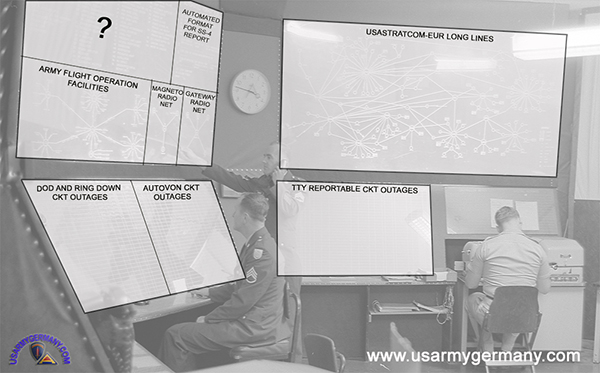 Headings of the various status boards |
||||||||||||||||||||||||||||||||||||
| Signal Service Group 4 moved from McGraw Kaserne, Munich to Neureut Kaserne, Karlsruhe sometime in early 1970. If anyone has information on the Sig Svc Gp or the move in 1970s, please contact the webmaster. |
||||||||||||||||||||||||||||||||||||
| Signal Service Battalion 4 | ||||||||||||||||||||||||||||||||||||
| (Source: STARS & STRIPES, July 8, 1967) | ||||||||||||||||||||||||||||||||||||
| Three signal companies (previously attached to the 1st Sig Gp in France) that provide signal support to ComZ have been relieved from attachment to the 1st and attached to STRATCOM's 4th Sig Gp. The three companies are the 256th, 269th and 532nd Signal Companies. It was announced that all signal support to ComZ will become the responsibility of the 4th Group (excluding depot signal maintenance and photographic support). As part of the reorganization, the three former TOE companies have been reorganized as TDA units and redesignated as Signal Service Units Worms, Sandhofen and Zweibrücken. Furthermore, the three SSU's will make up a new battalion to be designated as Sig Svc Bn 4, under Capt David C. Anderson, acting commander. |
||||||||||||||||||||||||||||||||||||
| SIGNAL articles | ||||||||||||||||||||||||||||||||||||
| (Source: SIGNAL, July 1962 issue) | ||||||||||||||||||||||||||||||||||||
| The reconstitution
of the US Army 4th Signal Group, with
headquarters in Heidelberg, Germany, has been announced by Colonel
William Scandrett, Commanding Officer of the US Army Signal Brigade,
Europe. Colonel John P. Scroggs, former Deputy Commanding Officer of the Signal Brigade, was named to command the 4th Signal Group, having an authorized strength of almost 2,500 personnel. The mission of the 4th Signal Group is to install, operate and maintain the Army portion of the World-wide Defense Communications System in Europe, the US Military Microwave Radio Relay System in Europe and to provide communication support for Headquarters, USAREUR. The European portion of the Defense Communications System consists primarily of long-range high frequency radio, and leased long lines. The 4th Signal Group operates Defense Communications System relay centers at Pirmasens, Germany; Saran, France and Leghorn, Italy. The Group also operates the Signal Center, USAREUR, at Heidelberg, Germany. The Army portion of the US Military Microwave Radio Relay System in Europe consists of 49 separate, fixed radio stations scattered throughout Germany and France and is operated by the 102nd Signal Battalion of the Group. The Group also operates the 2,800-line dial exchange serving USAREUR Headquarters, Heidelberg. |
||||||||||||||||||||||||||||||||||||
|
|
||||||||||||||||||||||||||||||||||||
| Related Links: 2005th Communications Squadron, Siegelbach, Germany - great site with lots of history, photos and other information going back to 1953. Siegelbach was a major teletype relay station and later AUTODIN station near Kaiserslautern that was operated by the Air Force. (Broken LINK) |
||||||||||||||||||||||||||||||||||||
|
||||||||||||||||||||||||||||||||||||
